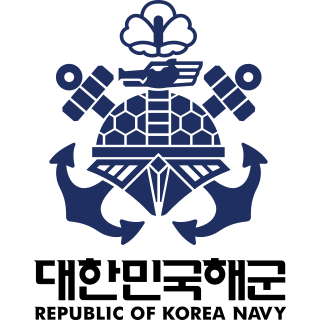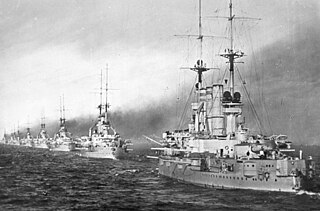
A flotilla (from Spanish, meaning a small flota (fleet) of ships), or naval flotilla, is a formation of small warships that may be part of a larger fleet.

A flotilla (from Spanish, meaning a small flota (fleet) of ships), or naval flotilla, is a formation of small warships that may be part of a larger fleet.
A flotilla is usually composed of a homogeneous group of the same class of warship, such as frigates, destroyers, torpedo boats, submarines, gunboats, or minesweepers. Groups of larger warships are usually called squadrons, but similar units of non-capital ships may be called squadrons in some instances, and flotillas in others. Formations including more than one capital ship, e.g. men-of-war, battleships, and aircraft carriers, typically alongside smaller ships and support craft, are typically called fleets, each portion led by a capital ship being a squadron or task force (see reference below).
A flotilla is usually commanded by a rear admiral, a commodore or a captain, depending on the importance of the command (a vice admiral would normally command a squadron). A flotilla is often divided into two or more divisions, each of which might be commanded by the most senior commander, nearly always a lieutenant at the very least. A flotilla is often, but not necessarily, a permanent formation.
In modern navies, flotillas have tended to become administrative units containing several squadrons. [1] As warships have grown larger, the term squadron has gradually replaced the term flotilla for formations of destroyers, frigates and submarines in many navies.
A naval flotilla has no direct equivalent on land, but is, perhaps, the rough equivalent in tactical value of a brigade or regiment.
In the United States Coast Guard Auxiliary, a flotilla is the basic organizational unit and consists of members at a local level where the majority of the work of the auxiliary is done. A flotilla is led by an elected flotilla commander assisted by an elected vice flotilla commander, who is in turn assisted by appointed flotilla staff officers. [2] A Coast Guard Auxiliary division consists of multiple flotillas and a district consists of multiple divisions. Auxiliary districts are organized along Coast Guard district lines and are administered by a Coast Guard officer (usually a commander or captain) who is called the "director of the auxiliary".
In the Imperial Russian Navy, Soviet Navy, and Russian Federation Navy, the word flotilla has tended to be used for "brown-water" naval units – those operating not on the oceans and real seas, but on inland seas or rivers. Among the former are the present-day Caspian Flotilla, the early-20th-century Satakundskaya Flotilla, or the Aral Flotilla of the 1850s; [3] among the latter, the Don Military Flotilla (which was created several times over more than 200 years), the Dnieper Flotilla (also extant in the 18th and 20th centuries), the Red Volga Flotilla, which participated in the Kazan Operation during the Russian Civil War, and the Danube Flotilla. In the 18th century, the term also applied to the comparatively small fleets operating on those seas where Russia did not have much naval presence yet, e.g. the Okhotsk Flotilla.
The word flotilla has also been used at times to refer to a small fleet of vessels, commercial or otherwise. [4] There is also such a thing as a "flotilla holiday", which is a group of chartered yachts that set sail together on the same route. Also outside of a military context, the Center for International Maritime Security, an open-membership Naval Strategy think tank based in the United States, maintains a similar use of the word Flotilla to that of the United States Coast Guard Auxiliary. In this context, Flotilla refers to a specialized sub-group of individuals within the broader organization, such as the Center's Warfighting Flotilla. [5]
Commodore is a senior naval rank used in many navies which is equivalent to brigadier or brigadier general and air commodore. It is superior to a navy captain, but below a rear admiral. It is either regarded as the most junior of the flag officers rank or may not hold the jurisdiction of a flag officer at all depending on the officer's appointment. Non-English-speaking nations commonly use the rank of flotilla admiral, counter admiral, or senior captain as an equivalent, although counter admiral may also correspond to rear admiral lower half abbreviated as RDML.

The United States Pacific Fleet (USPACFLT) is a theater-level component command of the United States Navy, located in the Pacific Ocean. It provides naval forces to the Indo-Pacific Command. Fleet headquarters is at Joint Base Pearl Harbor–Hickam, Hawaii, with large secondary facilities at Naval Air Station North Island, California.

The Home Fleet was a fleet of the Royal Navy that operated from the United Kingdom's territorial waters from 1902 with intervals until 1967. In 1967, it was merged with the Mediterranean Fleet creating the new Western Fleet.

The United States Coast Guard Auxiliary is the uniformed, non-military volunteer component of the United States Coast Guard. Congress established the unit on 23 June 1939, as the United States Coast Guard Reserve. On February 19, 1941, the entity was renamed the United States Coast Guard Auxiliary. The Auxiliary's purpose is to bolster all USCG undertakings both at sea and in the sky, with the exception of tasks necessitating "direct" law enforcement or military actions. As of 2022, the U.S. Coast Guard Auxiliary boasted around 21,000 members.

A fleet or naval fleet is a large formation of warships – the largest formation in any navy – controlled by one leader. A fleet at sea is the direct equivalent of an army on land.
A destroyer squadron is a naval squadron or flotilla usually consisting of destroyers rather than other types of vessel. In some navies other vessels, such as frigates, may be included. In English the word "squadron" tends to be used for larger and "flotilla" for smaller vessels; both may be used for destroyer units. Similar formations are used in non-English-speaking countries, e.g., the "escadrille"—which would translate directly as "squadron"—in France.
A submarine squadron (SUBRON) is a naval formation or unit in such states such as the United Kingdom, United States, and Russia/Soviet Union. In France the equivalent unit is the escadrille des sous-marins nucléaires d'attaque (ESNA), part of the French submarine forces.
In Japanese, sentai (戦隊) is a military unit and may be literally translated as "squadron", "task force", "division ", "group" or "wing". The terms "regiment" and "flotilla", while sometimes used as translations of sentai, are also used to refer to larger formations.

The first USS Yarnall (DD–143) was a Wickes-class destroyer in the United States Navy during World War I later transferred to the Royal Navy as HMS Lincoln, to the Royal Norwegian Navy as HNoMS Lincoln, and subsequently to the Soviet Navy as Druzhny.

The Baltic Fleet is the fleet of the Russian Navy in the Baltic Sea.

The Republic of Korea Navy, also known as the ROK Navy or South Korean Navy, is the naval warfare service branch of the South Korean armed forces, responsible for naval and amphibious operations. The ROK Navy includes the Republic of Korea Marine Corps, which functions as a branch of the Navy. The ROK Navy has about 70,000 regular personnel including 29,000 Republic of Korea Marines. There are about 140 commissioned ships in the ROK Navy. The naval aviation force consists of about 70 fixed-wing and rotary-wing aircraft. The ROK Marine Corps has about 300 tracked vehicles including assault amphibious vehicles.
Commodore was an early title and later a rank in the United States Navy, United States Coast Guard and the Confederate States Navy, and also has been a rank in the United States Public Health Service Commissioned Corps and the National Oceanic and Atmospheric Administration Commissioned Officer Corps and its ancestor organizations. For over two centuries, the designation has been given varying levels of authority and formality.

A squadron, or naval squadron, is a significant group of warships which is nonetheless considered too small to be designated a fleet. A squadron is typically a part of a fleet. Between different navies there are no clear defining parameters to distinguish a squadron from a fleet, and the size and strength of a naval squadron varies greatly according to the country and time period. Groups of small warships, or small groups of major warships, might instead be designated flotillas by some navies according to their terminology. Since the size of a naval squadron varies greatly, the rank associated with command of a squadron also varies greatly.

Military organization (AE) or military organisation (BE) is the structuring of the armed forces of a state so as to offer such military capability as a national defense policy may require. Formal military organization tends to use hierarchical forms.
The structure of the United States Navy consists of four main bodies: the Office of the Secretary of the Navy, the Office of the Chief of Naval Operations, the operating forces, and the Shore Establishment.

The Commander, Naval Surface Force, Atlantic (COMNAVSURFLANT) is the Surface Force Type Commander (TYCOM) under the United States Fleet Forces Command. As Naval Surface Force Atlantic, it is a military formation, and the organization is often known as SURFLANT. Its headquarters are at Naval Station Norfolk in Norfolk, Virginia. The current commander is Rear Admiral Joseph F. Cahill III. COMNAVSURFLANT supervises all surface ships based on the Eastern United States and Gulf Coast of the United States, as well as ships forward deployed to Naval Station Rota, Spain.

The Pacific Fleet is the Russian Navy fleet in the Pacific Ocean. Established in 1731 as part of the Imperial Russian Navy, the fleet was known as the Okhotsk Military Flotilla (1731–1856) and Siberian Military Flotilla (1856–1918), formed to defend Russian interests in the Russian Far East region along the Pacific coast. In 1918 the fleet was inherited by the Russian Soviet Federative Socialist Republic, then the Soviet Union in 1922 as part of the Soviet Navy, being reformed several times before being disbanded in 1926. In 1932 it was re-established as the Pacific Fleet, and was known as the Red Banner Pacific Fleet after World War II as it had earned the Order of the Red Banner. In the Soviet years, the fleet was also responsible for the Soviet Navy's operations in the Indian Ocean and Arabian Sea. Following the collapse of the Soviet Union in 1991, the Red Banner Pacific Fleet was inherited by the Russian Federation as part of the Russian Navy and its current name was adopted.

In the United States Navy, United States Coast Guard, United States Public Health Service Commissioned Corps (USPHS), and National Oceanic and Atmospheric Administration Commissioned Officer Corps, captain is the senior-most commissioned officer rank below that of flag officer. The equivalent rank is colonel in the United States Army, Air Force, Space Force, and Marine Corps.

Surface flotillas of the Kriegsmarine were organizational groupings of German naval vessels during World War II based on class of vessel and geographical location. Surface flotillas were not operationally deployed units, but functioned through the administrative command chain of the Kriegsmarine.
The 4th Destroyer Squadron was a naval unit of the Royal Navy from 1951 to 1959.